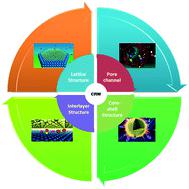当前位置:
X-MOL 学术
›
Catal. Sci. Technol.
›
论文详情
Our official English website, www.x-mol.net, welcomes your feedback! (Note: you will need to create a separate account there.)
Constructing Ni-based confinement catalysts with advanced performances toward the CO2 reforming of CH4: state-of-the-art review and perspectives
Catalysis Science & Technology ( IF 5 ) Pub Date : 2021-08-19 , DOI: 10.1039/d1cy01039e Yingying Xue 1 , Leilei Xu 1 , Mindong Chen 1 , Cai-e Wu 2 , Ge Cheng 1 , Ning Wang 3 , Xun Hu 4
Catalysis Science & Technology ( IF 5 ) Pub Date : 2021-08-19 , DOI: 10.1039/d1cy01039e Yingying Xue 1 , Leilei Xu 1 , Mindong Chen 1 , Cai-e Wu 2 , Ge Cheng 1 , Ning Wang 3 , Xun Hu 4
Affiliation

|
In recent years, the global greenhouse effect has been receiving more and more attention due to the increasing emission of greenhouse gases. CO2 and CH4 have been widely considered as the main greenhouse gases causing global warming and climate change. The CO2 reforming of CH4 (CRM) reaction can simultaneously convert both CO2 and CH4 into value-added synthesis gas (H2 + CO) and also alleviate the emission of these two greenhouse gases. Ni-Based catalysts have been widely investigated as the most promising candidates for CRM owing to their advanced activities and low price. However, the Ni-based catalysts usually suffer rapid deactivation due to the thermal sintering of metallic Ni active sites and surface carbon deposition during the CRM reaction at high temperatures (>640 °C). To address this challenge, researchers worldwide have devoted great efforts to developing highly efficient and stable Ni-based catalysts. However, it is extremely difficult to achieve this aim by using the traditional supported catalysts because of the weak metal–support interaction. Therefore, the concept of Ni-based confinement catalysts, such as core–shell catalysts, mesoporous catalysts, layered catalysts, and Ni-containing crystalline compound catalysts, have been proposed and developed to address the challenge of the thermal sintering of the metallic Ni active sites by the space and/or lattice confinement effects of these structures. As a result, the metallic Ni active site can be firmly stabilized and the surface carbon deposition can be effectively inhibited owing to the size effect of the metallic Ni active sites. This review mainly summarizes the state-of-the-art progress of the Ni-based confinement catalysts with advanced performances for CRM. Specifically, the Ni-based catalysts with different confinement types, including pore channel confinement, core–shell structure confinement, interlayer structure confinement, and crystalline lattice confinement, have been summarized. The significant impacts of the confinement effect on the stabilization of the Ni-based CRM catalysts are discussed in detail. The influences of the preparation methods on the catalytic performance of the Ni-based catalysts are also discussed and their development trends have been determined.
中文翻译:

构建具有先进性能的镍基限制催化剂以实现 CH4 的 CO2 重整:最新评论和展望
近年来,由于温室气体排放的增加,全球温室效应越来越受到重视。CO 2和CH 4已被广泛认为是导致全球变暖和气候变化的主要温室气体。CH 4 (CRM)反应的CO 2重整可以同时将CO 2和CH 4转化为具有附加值的合成气(H 2+ CO) 并减少这两种温室气体的排放。镍基催化剂由于其先进的活性和低廉的价格而被广泛研究为最有前途的 CRM 候选者。然而,由于金属镍活性位点的热烧结和高温(>640°C)CRM反应过程中的表面碳沉积,镍基催化剂通常会快速失活。为了应对这一挑战,世界各地的研究人员致力于开发高效稳定的镍基催化剂。然而,由于金属-载体相互作用较弱,使用传统的负载型催化剂很难实现这一目标。因此,Ni基限制催化剂的概念,如核壳催化剂、介孔催化剂、层状催化剂、已经提出并开发了含 Ni 结晶化合物催化剂,以解决这些结构的空间和/或晶格限制效应对金属 Ni 活性位点的热烧结的挑战。结果,金属Ni活性位点可以牢固地稳定并且由于金属Ni活性位点的尺寸效应可以有效地抑制表面积碳。本综述主要总结了具有先进性能的 CRM 镍基限制催化剂的最新进展。具体来说,总结了具有不同限制类型的镍基催化剂,包括孔道限制、核壳结构限制、层间结构限制和晶格限制。详细讨论了限制效应对 Ni 基 CRM 催化剂稳定性的显着影响。还讨论了制备方法对镍基催化剂催化性能的影响,并确定了它们的发展趋势。
更新日期:2021-09-08
中文翻译:

构建具有先进性能的镍基限制催化剂以实现 CH4 的 CO2 重整:最新评论和展望
近年来,由于温室气体排放的增加,全球温室效应越来越受到重视。CO 2和CH 4已被广泛认为是导致全球变暖和气候变化的主要温室气体。CH 4 (CRM)反应的CO 2重整可以同时将CO 2和CH 4转化为具有附加值的合成气(H 2+ CO) 并减少这两种温室气体的排放。镍基催化剂由于其先进的活性和低廉的价格而被广泛研究为最有前途的 CRM 候选者。然而,由于金属镍活性位点的热烧结和高温(>640°C)CRM反应过程中的表面碳沉积,镍基催化剂通常会快速失活。为了应对这一挑战,世界各地的研究人员致力于开发高效稳定的镍基催化剂。然而,由于金属-载体相互作用较弱,使用传统的负载型催化剂很难实现这一目标。因此,Ni基限制催化剂的概念,如核壳催化剂、介孔催化剂、层状催化剂、已经提出并开发了含 Ni 结晶化合物催化剂,以解决这些结构的空间和/或晶格限制效应对金属 Ni 活性位点的热烧结的挑战。结果,金属Ni活性位点可以牢固地稳定并且由于金属Ni活性位点的尺寸效应可以有效地抑制表面积碳。本综述主要总结了具有先进性能的 CRM 镍基限制催化剂的最新进展。具体来说,总结了具有不同限制类型的镍基催化剂,包括孔道限制、核壳结构限制、层间结构限制和晶格限制。详细讨论了限制效应对 Ni 基 CRM 催化剂稳定性的显着影响。还讨论了制备方法对镍基催化剂催化性能的影响,并确定了它们的发展趋势。



























 京公网安备 11010802027423号
京公网安备 11010802027423号